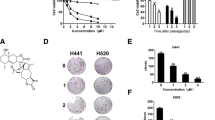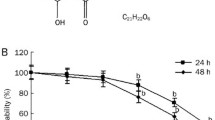Abstract
Objective
Zunyimycin C is a novel halogenated type II polyketide derived from the fermentation product of the Streptomyces species with notable antibiotic activity. However, it is still unclear whether zunyimycin C could inhibit the activity of cancer cells. In this study, human lung adenocarcinoma cell line A549, the large-cell lung cancer cell line NCI-H460 and the non-small-cell lung cancer cell line NCI-H1299 were employed to determine the in vitro anticancer properties of zunyimycin C and underlying molecular mechanisms.
Materials and methods
The cellular viability and proliferative properties of lung cancer cells were investigated using the Cell Counting Kit-8 and colony formation assay, respectively. The mRNA expression of apoptotic genes related to lung cancer was studied using reverse-transcription polymerase chain reaction. The apoptotic ratio was measured through flow cytometry. The protein expression was visualized via western blotting using specific antibodies.
Results
Zunyimycin C could inhibit cell proliferation and induce apoptosis in a dose-dependent manner. The expression levels of apoptosis-related proteins (i.e., BAX, cleaved-caspase-3, and cleaved-caspase-9) were increased compared with the control group. However, the levels of Bcl-2 and phosphorylated AKT were decreased by administration by zunyimycin C.
Conclusions
Collectively, these results implied that zunyimycin C could inhibit cell proliferation and induce apoptosis via AKT phosphorylation.





Similar content being viewed by others
References
Ahn DS, Lee HJ, Hwang J et al. (2018) Lambertianic acid sensitizes non-small cell lung cancers to TRAIL-induced apoptosis via inhibition of XIAP/NF-κB and activation of caspases and death receptor 4. Int J Mol Sci 19(5):1476
Andreu-Fernández V, Sancho M, Genovés A et al. (2017) Bax transmembrane domain interacts with prosurvival Bcl-2 proteins in biological membranes. Proc Natl Acad Sci USA 114(2):310–315
Byers LA, Rudin CM (2015) Small cell lung cancer: where do we go from here? Cancer 121:664–672
Barka EA, Vatsa P, Sanchez L et al. (2016) Taxonomy, physiology, and natural products of actinobacteria. Microbiol Mol Biol Rev 80(1):1–43
Boichuk S, Lee DJ, Mehalek KR et al. (2014) Unbiased compound screening identifies unexpected drug sensitivities and novel treatment options for gastrointestinal stromal tumors. Cancer Res 74(4):1200–1213
Booth LA, Tavallai S, Hamed HA et al. (2014) The role of cell signalling in the crosstalk between autophagy and apoptosis. Cell Signal 26(3):549–555
Birkinshaw RW, Czabotar PE (2017) The BCL-2 family of proteins and mitochondrial outer membrane permeabilisation. Semin Cell Dev Biol 72:152–162
Chen W, Zheng R, Baade PD et al. (2016) Cancer statistics in China, 2015. Cancer J Clin 66(2):115–132
Chen Y, Tang Q, Xiao Q et al. (2017) Targeting EP4 downstream c-Jun through ERK1/2-mediated reduction of DNMT1 reveals novel mechanism of solamargine inhibited growth of lung cancer cells. J Cell Mol Med 21:222–233
Deben C, Lardon F, Wouters A et al. (2016) APR-246 (PRIMA-1(MET)) strongly synergizes with AZD2281 (olaparib) induced PARP inhibition to induce apoptosis in non-small cell lung cancer cell lines. Cancer Lett 375(2):313–322
Fei HR, Tian H, Zhou XL et al. (2016) Inhibition of autophagy enhances effects of PF-04691502 on apoptosis and DNA damage of lung cancer cells. Int J Biochem Cell Biol 78:52–62
Fouillaud M, Venkatachalam M, Girard-Valenciennes E et al. (2016) Anthraquinones and derivatives from marine-derived fungi: structural diversity and selected biological activities. Mar Drugs 14(4):64
Franke TF (2008) PI3K/Akt: getting it right matters. Oncogene 27(50):6473–6488
Guise CP, Mowday AM, Ashoorzadeh A et al. (2014) Bioreductive prodrugs as cancer therapeutics: targeting tumor hypoxia. Chin J Cancer 33(2):80–86
Hadjithomas M, Chen IA, Chu K et al. (2017) IMG-ABC: new features for bacterial secondary metabolism analysis and targeted biosynthetic gene cluster discovery in thousands of microbial genomes. Nucleic Acids Res 45(D1):D560–D565
Hansakul P, Aree K, Tanuchit S, Itharat A (2014) Growth arrest and apoptosis via caspase activation of dioscoreanone in human non-small-cell lung cancer A549 cells. BMC Complement Altern Med 14:413
Hassan M, Watari H, AbuAlmaaty A et al. (2014) Apoptosis and molecular targeting therapy in cancer. Biomed Res Int 2014:150845
Herman NA, Kim SJ, Li JS et al. (2017) The industrial anaerobe Clostridium acetobutylicum uses polyketides to regulate cellular differentiation. Nat Commun 8(1):1514
Hong QY, Wu GM, Qian GS et al. (2015) Prevention and management of lung cancer in China. Cancer 121:3080–3088
Hua F, Shang S, Hu ZW (2017) Seeking new anti-cancer agents from autophagy-regulating natural products. J Asian Nat Prod Res 19(4):305–313
Jacobsen K, Bertran-Alamillo J, Molina MA et al. (2017) Convergent Akt activation drives acquired EGFR inhibitor resistance in lung cancer. Nat commun 8(1):410
Kang Y, Wang ZJ, Xie D et al. (2017) Characterization and potential antitumor activity of polysaccharide from Gracilariopsis lemaneiformis. Mar Drugs 15(4):100
Kawada M, Kawatsu M, Masuda T et al. (2003) Specific inhibitors of protein phosphatase 2A inhibit tumor metastasis through augmentation of natural killer cells. Int Immunopharmacol 3(2):179–188
Kinghorn AD, DE Blanco EJ, Lucas DM et al. (2016) Discovery of anticancer agents of diverse natural origin. Anticancer Res 36(11):5623–5637
Kodali S, Galgoci A, Young K et al. (2005) Determination of selectivity and efficacy of fatty acid synthesis inhibitors. J Biol Chem 280(2):1669–1677
Lü Y, Shao M, Wang Y et al. (2017) Zunyimycins B and C, new chloroanthrabenzoxocinones antibiotics against methicillin-resistant Staphylococcus aureus and Enterococci from Streptomyces sp. FJS31-2. Molecules 22(2):251
Liu W, Christenson SD, Standage S, Shen B (2002) Biosynthesis of the enediyne antitumor antibiotic C-1027. Science 297(5584):1170–1173
Li JS, Zhang H, Qi H et al. (2018) Bioactive naphthoquinone and anthrone derivatives from endophytic Micromonospora sp. NEAU-gq13. J Asian Nat Prod Res 26:1–10
Li X, Zeng X, Sun J et al. (2014) Imperatorin induces Mcl-1 degradation to cooperatively trigger Bax translocation and Bak activation to suppress drug-resistant human hepatoma. Cancer Lett 348(1-2):146–155
Lu C, Zhao Y, Jia WQ et al. (2017) A new anthracycline-type metabolite from Streptomyces sp. NEAU-L3. J Antibiot 70(10):1026–1028
Luo X, Luo W, Lin C et al. (2014) Andrographolide inhibits proliferation of human lung cancer cells and the related mechanisms. Int J Clin Exp Med 7:4220–4225
Manning BD, Cantley LC (2007) AKT/PKB signaling: navigating downstream. Cell 129(3):1261–1274
Mei C, Zhou S, Zhu L et al. (2017) Antitumor effects of laminaria extract fucoxanthin on lung cancer. Mar Drugs 15(2):39
Newman DJ, Cragg GM, Snader KM (2003) Natural products as sources of new drugs over the period 1981–2002. J Nat Prod 66:1022–1037
Pan LL, Wang XL, Zhang QY et al. (2016) Boehmenan, a lignan from the Chinese medicinal plant Clematis armandii, induces apoptosis in lung cancer cells through modulation of EGF-dependent pathways. Phytomedicine 23(5):468–476
Pinkhien T, Maiuthed A, Chamni S et al. (2016) Bishydroquinone renieramycin M induces apoptosis of human lung cancer cells through a mitochondria-dependent pathway. Anticancer Res 36(12):6327–6333
Reyna DE, Garner TP, Lopez A et al. (2017) Direct activation of BAX by BTSA1 overcomes apoptosis resistance in acute myeloid leukemia. Cancer Cell 32(4):490–505
Robles AI, Harris CC (2017) Integration of multiple “OMIC” biomarkers: a precision medicine strategy for lung cancer. Lung Cancer 107:50–58
Shi H, Bi H, Sun X et al. (2018) Antitumor effects of tubeimoside-1 in NCI-H1299 cells are mediated by microRNA-126-5p-induced inactivation of VEGF-A/VEGFR-2/ERK signaling pathway. Mol Med Rep 17(3):4327–4336
Son S, Ko SK, Jang M et al. (2017) Polyketides and anthranilic acid possessing 6-deoxy-α-l-talopyranose from a Streptomyces species. J Nat Prod 80(5):1378–1386
Torre LA, Bray F, Siegel RL et al. (2015) Global cancer statistics, 2012. Cancer J Clin 65:87–108
Trédan O, Galmarini CM, Patel K, Tannock IF (2007) Drug resistance and the solid tumor microenvironment. J Natl Cancer Inst 99:1441–1454
Wang CY, Bai XY, Wang CH (2014) Traditional Chinese medicine: a treasured natural resource of anticancer drug research and development. Am J Chin Med 42:543–559
Wang M, Li Y, Shao M et al. (2014) Separation and phylogenetic analysis of actinomycetes with activity of against Candida albicans from Chishui danxia soil. J Zunyi Med Univ 37(4):404–408.
Wang Y, Shao M, Yue C (2016) Research development of halogenated natural products derived microorganisms. J Zunyi Med Univ 39(4):435–440.
Wei WT, Lin SZ, Liu DL, Wang ZH (2013) The distinct mechanisms of the antitumor activity of emodin in different types of cancer (Review). Oncol Rep 30(6):2555–2562
Xu P, Cai X, Zhang W et al. (2016) Flavonoids of Rosa roxburghii Tratt exhibit radioprotection and anti-apoptosis properties via the Bcl-2(Ca2+)/Caspase-3/PARP-1 pathway. Apoptosis 21(10):1125–1143
Yu P, Shi L, Song M, Meng Y (2017) Antitumor activity of paederosidic acid in human non-small cell lung cancer cells via inducing mitochondria-mediated apoptosis. Chem Biol Inter 269:33–40
Zarogoulidis P, Petanidis S, Kioseoglou E et al. (2015) MiR-205 and miR-218 expression is associated with carboplatin chemoresistance and regulation of apoptosis via Mcl-1 and Survivin in lung cancer cells. Cell Signal 27(8):1576–1588
Zhou L, Wu F, Jin W et al. (2017) Theabrownin inhibits cell cycle progression and tumor growth of lung carcinoma through c-myc-related mechanism. Front Pharm 8:75
Zhou R, Chen H, Chen J et al. (2018) Extract from Astragalus membranaceus inhibit breast cancer cells proliferation via PI3K/AKT/mTOR signaling pathway. BMC Complement Alter Med 18:83
Zhu X, Jiang H, Li J et al. (2016) Anticancer effects of Paris saponins by apoptosis and PI3K/AKT Pathway in gefitinib-resistant non-small cell lung cancer. Med Sci Monit 22:1435–1441
Acknowledgements
The Authors would like to thank Yun Liu for his assistance with flow cytometry and Sanhua Li for her technical assistance. Especially, thanks to Changwu Yue for providing test compound of zunyimycin C. This work was funded by the National Nature Science Foundation of China (Grant no. 31460006), the Science and Technology Foundation of Guizhou Province (no. (2013) 3013).
Authors’ contributions
Study design: YB. Data acquisition: WL. Data analysis and interpretation: YB, ZQ, and WL. Statistical analysis: WL. Manuscript writing: WL. Manuscript editing: YB, ZQ. Manuscript review: WL, JZ, WW, YB, and ZQ.
Author information
Authors and Affiliations
Corresponding author
Ethics declarations
Conflict of interest
The authors declare that they have no conflict of interest.
Additional information
Publisher’s note: Springer Nature remains neutral with regard to jurisdictional claims in published maps and institutional affiliations.
Rights and permissions
About this article
Cite this article
Li, W., Zheng, J., Wang, W. et al. Zunyimycin C inhibits the proliferation of lung cancer cells by inducing apoptosis through an AKT-related mechanism. Med Chem Res 28, 1828–1837 (2019). https://doi.org/10.1007/s00044-019-02417-2
Received:
Accepted:
Published:
Issue Date:
DOI: https://doi.org/10.1007/s00044-019-02417-2




